This week in the Plant Clinic, Master Gardener Volunteer Jan Mangos answers a question about School Gardens. You can read more articles by Jan [here].
Rewards & Challenges of School Gardens
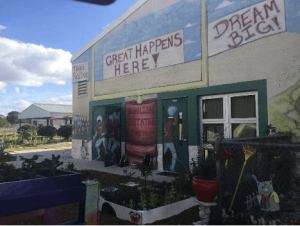
Most people would agree that a school garden benefits everyone involved. Students learn about nature and how their food is grown, participate in planning, planting, and maintaining of the garden, and take pride in their success.Teachers gain a new teaching tool suitable for many subjects – science, math, physical education and history, among others. All participants learn the benefits of working together in spite of differences in language, background or ability.
Despite the many benefits, creating and maintaining a school garden year after year can be a challenge. Enthusiasm may be high during the first year, but wears thin with repetition.
One school that has successfully maintained its garden for nearly four years is English Estates Elementary School, located just north of Orlando in Fern Park, Florida.
A Little About English Estates Elementary School
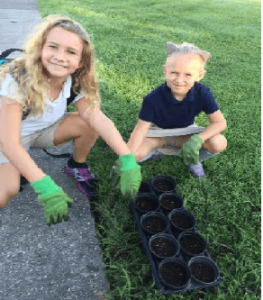
The school is a Title 1 school with almost 800 students in grades PreK-5 and more than 85 teachers and staff members. It also has the distinction of being the 2nd school in the world designated as a Leader in Me school by the Franklin Covey Institute, in 2005. The first school to adopt this program was A.B. Combs Elementary School in Raleigh, NC, in 1999. There are now over 4,000 schools designated Leader in Me Schools and only 417 Lighthouse Schools. English Estates Elementary has since achieved the higher distinction of being named a Lighthouse School.
The Leader in Me program is based on the principles outlined in Stephen Covey’s 1989 book, The 7 Habits of Highly Effective People. Its mission is to incorporate the teaching of life skills with academics in schools around the world.
A Growing School Garden
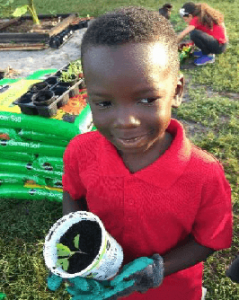
The garden was started in 2015 when the principal realized that a large open space between buildings needed “a tree”.
Since then, PE teacher Marie Spoon has been the guiding force of the garden, adding far more than that lone tree! A virtually new gardener, Marie realized early that having a garden would benefit that students at English Estates. Two students I met in the garden confirmed that belief, telling me that the garden was “”the coolest thing in the school because we can eat food as it’s growing…. plus it’s a fun place to hang out.”
Over the years, the garden has grown to include a 60’ X 25’ area of beds which produce varied combinations of beans, eggplant, tomatoes, pineapple, lettuce, strawberries, zucchini, corn, cucumbers, peppers, herbs, and many other edible plants. Adjacent to the garden area, there’s a large pergola with benches that often serves as an outdoor classroom. English Estates also has an alternate space where there are several work and storage areas for potting, composting and transplanting.
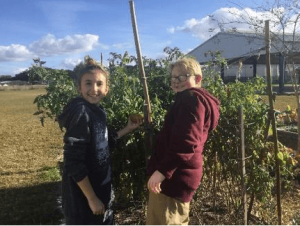
The garden is a focal point of the school. Located in a high-traffic area between classroom buildings, it creates a peaceful oasis in the midst of a very lively place.
While visiting with Marie and some of her students recently, it became clear from our conversation that there are five major sources of support needed for a successful long-term school garden.
One: A Strong School Garden Project Leader
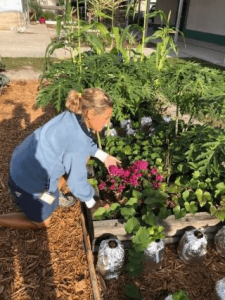
It’s often said that every successful project requires a dedicated and selfless leader. Marie faithfully and patiently fills that role at English Estates.
She offered some tips for newcomers to school gardening which she’s learned over the years:
- Start small and build over the years.
- Don’t be disappointed if things don’t happen as quickly as you had hoped.
- Continuously cultivate new sources of help and support.
- Be very appreciative of all the help you receive.
Two: Supportive Administrators
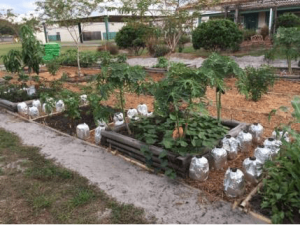
Support from school administrators is key to project success. Their full support is required for a successful and sustainable school garden.
In addition to being responsible for administrative decisions at their school, they are an important conduit to school district personnel. Major decisions and changes to the school’s grounds may require decisions at the district level.
Three: Engaged Parents and Students
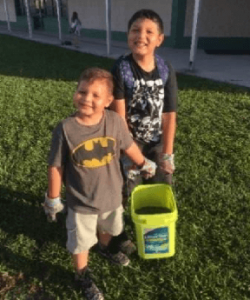
Consider that a school garden is first and foremost a place for the students (and their parents) to relax and learn about gardening. The English Estates Parent-Teacher Association (PTA) has given grant money to the garden for many purposes, including building the pergola. Many parents and other family helpers also spend time working in the garden. The school’s students are enthusiastic garden helpers. They plant, water, weed and harvest the “fruits” of their labor. They also keep a close eye on potential garden pests, and edibles coming to maturity.
Four: Involved Teachers and Staff Members
Make every effort to make people feel welcome in the garden. The garden may be enjoyed in different ways by different people. At English Estates, many teachers have integrated the garden into their lessons. It’s not unusual to see students measuring plants, writing, drawing, or enjoying other activities. Many students, teachers, staff members, parents, and members of the community visit the garden throughout the year to see what’s growing and what’s ready to eat. It’s a great place to meet and relax with friends.
Five: Supportive Community Members

If it takes a village to raise a child, it can also be said that it takes a village to support a school garden. According to Marie, the garden has received receives lots of support from the community. Local businesses have donated garden soil, mulch, peat moss, vermiculite, seeds and other items. Local residents have been generous in their support of the garden, too, donating two wheelbarrows, garden tools, plants, pots, mulch, and other supplies.
For more information on gardening in schools, go to https://edis.ifas.ufl.edu/fy1463
 0
0

Comments:
January 10, 2022
Hi Bruce, There is quite the diversity of farms in Seminole County! Many of these farms are private or do not market their products direct to the consumer. These are some of those farmers and markets that are accessible to the consumer. If there are other farms that you think should be added to the brochure, please let us know! We update the brochure annually and we would love reach out to any farms or markets that we are missing :)
January 10, 2022
400 turned into 33 entries
December 2, 2021
Hi Cindy, There are lots of local community groups that work on invasive species. I am located in Seminole County and I know of a few. One I work with regularly to host educational opportunities is the Central FL CISMA. I would check out their Facebook page for upcoming events: https://www.facebook.com/CFCISMA. The Cuplet Fern Chapter of the Native Plant Society focuses more on native plant species and sustainability so that might be another group to look into: https://www.facebook.com/cupletfernfnps.
December 2, 2021
Good Morning, Sustainability is important to me and I was trying to see if there are any local community groups you may be aware of related to this topic? I appreciate if you have any insights you could point me to a group I could learn and participate in future activities. Thank you, Cindy
September 13, 2021
Thank you so much for your question. Information on how to join 4-H may be found at:http://www.seminolecountyfl.gov/4-H. We'll also send some information to you via email. :)
September 13, 2021
Hi. How can I enroll my daughters in a 4H club?
August 3, 2021
As consumers, we want to know more about food and where it comes from. The farm tour video is the perfect way for viewers to get to know a dairy farming family. Take your students on a virtual field trip with these teacher-approved destinations, videos, and resources.
May 7, 2021
Wonderful! I am glad you got to see something new. Thanks for your feedback :)
May 7, 2021
I looked at all 6 even though I've been to at least 3 of the farms. The bee video was totally new and I found it particularly interesting. Thanks for the tours for 2021.
May 3, 2021
You are very welcome! Thank you for bringing to my attention that the closed captioning wasn't working properly on the beef video. I think I got it fixed, but if you have any issues, please let me know :)
May 3, 2021
Wonderful presentation and thank you for the closed captioning on all but the beef. Very helpful for me, being hearing impaired.
May 3, 2021
I am happy you enjoyed the videos! Thank you for your positive feedback. It was a really fun time putting them together.
May 1, 2021
These farm tour videos are great. Very informative and fun to learn and see the different local farms that we have. Even if you've been to these farms, these videos are fun education about them. Thank you for coordinating and putting these together.
April 27, 2021
Thank you very much for your wonderful feedback! It is incredible the work our farmers do in our own county. We appreciate you sharing the information with others :)
April 27, 2021
Thank you Morgan for the wonderful and educational farm tours! I watched all six tours! Love them! I do not know that cow is one of the local farm here in Florida! I will pass on this wonderful informational link to my Seminole friends. Thanks again!
April 23, 2021
Thank you for your kind words. I am very glad that you enjoyed the virtual farm tour videos!
April 23, 2021
It was very interesting learning more about Florida agriculture. Like the virtual tour as could go back and watch again to remember more.
October 23, 2020
Hi Gary, Thank you! This is something we may do in the future! UF/IFAS also has a lot of EDIS documents that are great resources for different fruit trees. If you haven't heard of our EDIS documents before, I would recommend checking them out. You can visit the EDIS homepage here: https://edis.ifas.ufl.edu/. The website allows you to search for specific topics that you are looking for. There are documents on lots of different things including some recommendations for growing different fruit trees.
October 22, 2020
Really well put together Dr. Morgan. Will you ever have a follow up on any specific fruit tree(s) that people have trouble growing here in Florida?
August 3, 2020
Hi Evelyne! This will entirely depend on the spray you plan to use. Read the label. It will tell you if it is safe to eat the fruit after spraying, if it should be sprayed a certain number of days before harvest, or if it is not safe at all to use on your tree. Hope that helps! Kaydie
July 31, 2020
We appreciate you sharing this message with others! The seed packets could be a risk to our agriculture and natural resources and we hope that others will take the message as seriously as you.
July 30, 2020
OMG, Thank you for exposing this! I just clicked on this to read about it from a person putting it on Facebook! I havent received any seed package and will definitely try my best to get the word out concerning this. I know about the horribly invasive plants, reptiles, etc, and the havoc they are causing . Hopefully we can catch this right away . And if we can catch the perpetrators,and severely punish them, all the better! Good Luck!
July 28, 2020
I planted Bambusa Guangxiensis "Chinese Dwarf" "China Doll" in a blank area in April 2019 Zone 9B Daytona. Within 6 months most of the neighbor was blocked, but now, at 15 months in he has disappeared from sight! I am thrilled. China Doll is a very dense, bushy, large leaf bamboo that provides a quick hedge with it's lush foliage. Will grow up to 20 feet, but easy PRUNING to any desired height makes this one a great choice for blocking an area from view. Plentiful leaves add to its unique beauty. It's good for cooler areas to about 26F
June 16, 2020
Thank you! I am very excited to share what I know with you.
June 16, 2020
Congratulations Morgan! I now can be your student. My recent interest in gardening has made me aware of all the good work you and your fellow extension agents do! I will be doing my best to follow you as you begin your career!
June 15, 2020
Hello Kaydie, I am experiencing infestation of mealybugs on my papaya tree; I had to throw some papaya fruits out because I even found maggot inside before ripened. Should I remove all fruits before spraying with fruit insect spray?
June 11, 2020
You bet! Find your agent here: https://sfyl.ifas.ufl.edu/find-your-local-office/
June 11, 2020
Hi Stefanie, It is best to work with a professional for diagnosis. If you send your local Extension Agent food photos, that can tell us a lot. If we suspect something more, we will recommend taking trunk samples, which again, is something you should work with a pro to do. It involves opening a wound directly into the tissue of the tree, and if not done properly, could be an invitation for disease.
June 11, 2020
Hi Lauren, the best practice is to replace with something different that is not susceptible to the disease.
June 11, 2020
Hi Janice, yellowing fronds are typically an indication of a nutrient deficiency which can usually be corrected with a good palm fertilizer for Florida. The diamond cut should be okay whether done before or after transplanting, but in general, we do not recommend pruning off palm fronds that are alive... only prune off dead brown fronds. This will prevent the opportunity for a disease to enter an open wound.
June 11, 2020
Hi Bill, Can you send me some pictures to hwooten@ufl.edu?
June 11, 2020
Wow! This can be one particular of the most useful blogs We ave ever arrive across on this subject. Actually Magnificent. I am also an expert in this topic so I can understand your effort.
May 23, 2020
Any thoughts about a central spear leaf yellow, but not (yet) brown or bottom fronds browning?? Two years after transplanting two ten ft sylvesters. Ugh. Thanks, Dogtorbill
May 14, 2020
Hi Darryl! I would recommend reaching out to the Marion County Museum of History and Archaeology to see if they can provide some help. I looked up their website and you can find it here: http://marioncountyarchaeology.com/mcmha/mcmha.htm Thank you for reading and good luck in your search!
May 13, 2020
Love this article. My wife and I have recently bought Mr. Frank Sampsons orginal home in boardman and are in the process of restoring it to original. We have found lots of history on the home and property but the one thing we cant find is actual pictures of the home and packing house. Any help would be greatly appreciated. Thank you
May 10, 2020
We are in the market to purchase a sylvester palm. What should we look for to identify a healthy palm? We have seen many with yellowing fronds. Are yellowing fronds an indication of a problem? Is it better to purchase a palm with a diamond cut trunk or better to have the diamond cut done after planting in our yard?
April 11, 2020
Good to know
March 23, 2020
Hi Sallie! I don't keep rabbits, and there isn't a central repository list of plants to check, so I asked our livestock agent, JK Yarborough (you can find his blog profile by clicking here). He let me know that as far as he is aware, dollarweed isn't toxic to rabbits, though he isn't sure if they'd have a preference for it over other things. If your rabbit accidentally eats some dollarweed, however, it isn't something to worry about. Hope that helps! Kaydie
March 23, 2020
Thanks for the correction Mari! =)
March 23, 2020
Hi Lindy! It spreads both by seeds and by its underground rhizome (those thick white stems/roots underground). If the rhizome is moved (say by mower blades) from one area to another it can spread that way, otherwise it will spread by seed.
March 23, 2020
Hi Keya! When I have tried to smother it in the past I have had mixed results. You could probably smother it with a thick layer of cardboard, but no guarantees it will not come back. Hand pulling can work if you get the whole root system up - but that can be difficult as well. Changes in your cultural practices can also slow it down - dollarweed usually likes a wet area, so if you can reduce irrigation or improve drainage, that might slow its growth in your garden. There are a lot of chemicals that can be used to treat for it, but if you can try to change the water, smother it, or handpull, that would be the safest option. You can find UF/IFAS's recommended chemicals for control of dollarweed here: https://edis.ifas.ufl.edu/ep389
March 23, 2020
Hi Sims! According to our UF/IFAS Website on crabgrass control, the time for pre-emergent application has already passed (back in February). They do have a list of both pre and post emergent herbicides to use on their website however. You can find the website at this link: https://edis.ifas.ufl.edu/ep395 The easier to read PDF version of the website is at this link: https://edis.ifas.ufl.edu/pdffiles/EP/EP39500.pdf In order to remain unbiased, only the chemical names have been provided, with no trade names. You'll have to look them up to see what brands are actually using those active ingredients. Let me know if you have further questions! Kaydie McCormick
March 22, 2020
I live in South Florida, and I am wondering about a pre-emergent for our St Augustine in particular to prevent crab grass from seeding. Is there one that I can recommend to our professional chemical guy and one that I can use myself as a homeowner? If yes to both, when are the best times to put them down? I am a snow bird, and we always put pre-emergent down in March up north, but our lawn care professional in Boynton beach has never heard of a pre-emergent for St Augustine. Yikes! Hard to keep up is we are doing nothing preventative down here, I think. Many thanks!
March 8, 2020
Can rabbits eat dollar weed?
March 1, 2020
What makes dollar weed go away can I smother it out? What can I do??
February 19, 2020
How does dollarweed spread?....Does that small pink flower that grows from a clump release seeds that spread around by the wind or run over by a lawnmower? Does the Bulb split and a new sprout happens?
December 23, 2019
Love the article! One little note, dollarweed is in the Apiaceae family, Hydrocotyle species
December 19, 2019
Great article. Marie Spoon is an inspiration for us all.
November 15, 2019
Hi Hava! Dollarweed is not a parasite (it doesn't steal nutrients directly from other plants) but it does compete for nutrients in the soil, just like all plants do. If it is better able to take up nutrients than a flowering plant - instances where soil conditions favor the dollarweed over the flowering plant would help with this - then it could possibly outgrow the other plants in a garden.
October 19, 2019
Is dollar weed hurting flower plants? Is like a parasite living off the plant and using its nutrients?
October 16, 2019
I had a Sylvester palm planted almost 6 months ago that is suffering with this disease. Our llandscapers who planted the tree are going to replace it with another Sylvester. But I’m a little concerned, will the next one suffer the same fate being planted in the same hole? What are my best options for the new palm tree to thrive? TIA
August 12, 2019
Hi Audrey! It is not a problem I have encountered before! As this is a pretty commonly eaten plant, it might be an allergy unique to just a few, or it could be something else in the soil that is causing your skin problems. I'm not a doctor though, just a plant nerd, so you might want to speak to a medical professional about it if it becomes a lingering problem. Thanks for reaching out! Kaydie
August 5, 2019
Has anyone ever developed blisters from hand weeding the roots? I seem to every time I dig deeply to remove the long, white root.
May 9, 2019
Thanks for this great stuff to write.
April 27, 2019
Ihave two selvester palms about 8foot tall and they both have trees i the ground for about 3 mounths. They are loseing tree branches layer by layer .iv done everything. Inow and still turning brown.if you have someone locol that i can talk to would be very much appreciated my numer is 561 #######. My name is randy gillespie i am in west palm beach.if you have any body i can hire. Or look at these trees i will defiantly take care of them.idont want to lose these tree's. Thanks or email this. Address back.
April 11, 2019
We hope so Joe! Starting a school garden is a large undertaking that needs plenty of hands helping to get started.
April 11, 2019
Thank you Nancy! We are so happy to have a great partner like Marie working with us at a school!
April 9, 2019
Thank you for this wonderful story. Marie Spoon is my sister and for this garden effort (and so many other reasons), I am indescribably proud of her!!
April 4, 2019
Great story that should embolden other schools to heed the educational pluses of gardening...
March 1, 2019
How do we do the test for diagnosis of TPPD? We have three Sylvester’s just installed in August 2018 and two appear to be on their way out.
February 15, 2019
Hello, I am the president of Bonafide Landscaping. I have a dear client that it appears has this Texas Phoenix Palm Decline aka TPPD. I have had multiple arborist look at her palm to try and help save it. I came across this and would love if I could ask for help. She has a beautiful Palm and would loose such a great house curb appeal if this palm dies.
January 17, 2019
Hi Chris, That is interesting and thank you for sharing! I wonder what the status will be in another 10 or 20 years? Can we get a follow up in 2029? Very best!
January 17, 2019
Hi Terese, Palms that are surviving with TPPD can be treated with Oxytetracycline (OTC) trunk injections for the rest of the life of the tree. This could get expensive, so I would recommend evaluating the value of the tree and whether it is worth treating for the remainder of its life. Palms come at all different price tags! Best of luck!
January 17, 2019
I have been treating palms for quite a while in Orlando, I've seen a lot. I've even seen a Canary expire from Ganoderma (no mistaking those conchs) then same spot replanted with Sylvester, no soil change out and it has been doing well for 10+ years...go figure!
January 15, 2019
where do you get the treatment for TPPD of which our landscaper has diagnosed our tree having this problem. Can this treament be done by us the homeowner or do we need to hire a landscaper to apply the treatment and what exactly is the process etc. We read the articles and testing menthods done but done have contact info on purchasing the product.please advise
December 28, 2018
Hi Brenda! It is nice to see someone else interested in the topic! This article was written by one of my former Master Gardener Volunteers, Kevin Said Jardaneh. He had a huge interest in the history of agriculture while he lived here in Florida. Unfortunately he moved to Oregon this summer. He did all of the research for this article - I just edited it and posted it for him. The only contact information I have for him is in the article. As he left UCF to pursue a position at a university in Oregon though, I'm not sure you'll be able to reach him there: jardaneh@knights.ucf.edu Kaydie McCormick
November 13, 2018
Hi, Kaydie - I enjoyed your article very much and wish you would do more research on Sampson and a multitude of other growers who, as you've noted, are absent from the Florida Citrus Hall of Fame. Like most other organizations of this kind, people have to be nominated and then voted upon for induction. The people who are willing to take the time and effort to do the research and submit those nominations are few and far between. People are quick to note that someone is not listed who should be included. However, without that effort, our committee has no information to review. You will be happy to know that Jo Kean submitted a nomination packet on Mr. Sampson, and he is up for review again. However, the information that she sent left out several key components which you reference in your article. I would like to obtain this additional information to either add to his packet for next year's consideration or hopefully use should he be chosen this year. Either way, I hope you will send out a call for action to other researchers and help us get more of our forgotten pioneers like Mr. Sampson on our ballot! Thank you for helping others rediscover our citrus heritage! All my best - Brenda Eubanks Burnette
November 10, 2018
Is there someone in manatee county as well?
October 3, 2018
Great article! Thank you.
September 18, 2018
I live in Altamonte Springs and have a "large family" of honey bees that now have a have filling my wood duck house. I planted lots of wild flowers to attract the ...and I did. I really need someone to come and relocate them.
September 9, 2018
Hydroponic gardening methods are a great way to provide fresh produce to the inmates at a low cost. More correctional facilities should incorporate programs like this which would ultimately reduce costs to taxpayers.
September 4, 2018
Hi Sarey! It took a little while to find a research paper discussing this, and unfortunately I can answer for a relative in the same Order, Centella asiatica, but not for our native dollarweed, Hydrocotyle bonariensis. They likely have similar, but not identical nutrient content. It would be an interesting study to conduct, as ethnobotany and utilizing plants we consider weeds in the garden is an emerging field of study and becoming more popular among the general public! "Leaves of the Asiatic pennywort are 87.7% moisture and 2% protein on a fresh weight basis (16.26% dryweight), 0.2% fat, 6.7% carbohydrate,1.6% fiber, and 1.6% ash (Bautista etal., 1988; Zanariah et al, 1986). Fresh leaves are an excellent source of vita-min C, containing about 7 mg/100 g(Gunasekara and Ravindran, 1989) and contain 738 IU of vitamin A and 0.09mg of vitamin B 1/100 g fresh edible material (Bautista et al., 1988). When the leaves are allowed to wilt, however,95% to 99% of the vitamin C is lost(Kailasapathy and Koneshan, 1986).The plant is also a relatively good source of the minerals Ca (171 mg/ 100 g edible), P (32), and Fe (5.6)(Bautista et al., 1988; Jayaweera, 1982;Turton, 1993). Leaf composition varies somewhat with location." Excerpted from: http://www.academia.edu/19351641/Asiatic_Pennywort_Centella_asiatica_L._Urb._A_little-known_vegetable_crop
September 3, 2018
Hi, What nutritional value does dollar weeds provide? Sarey
July 29, 2018
Hi, My name is Barbie. My 15 year old niece wants to be a veterinarian and I just came across this camp. Can you send me some info for us to look into this next year?
July 18, 2018
Hi John! It never hurts to reach out to your local UF/IFAS Citrus County Extension Office for some guidance on diagnosis and treatment. Here is their email: citrus@ifas.ufl.edu I would get a confirmation of diagnosis of TPPD as treatment is not cheap and it is continual. Good luck with your sylvester palm!
July 18, 2018
I believe I also have a Sylvester palm that may be suffering from this disease. I live in Citrus Cnty. . I have ordered the treatment for the disease mentioned which will arrive tomorrow. Sad to think it may be to late but I will try and hope for the best.
October 29, 2017
I appreciate the info. The more l know, the better l can treat my space. Thanks for the tips.
October 28, 2017
I love this, I have been doing this for years! Never waist good yard waist. My moto!!
October 23, 2017
Keep this going please, great job!
August 16, 2017
"I really like your writing style, good info, thanks for posting. “Let every man mind his own business.”
July 18, 2017
Thank you for the comment Brooks. Which post are you referring to? I'd be happy to answer any questions you have about 4-H and our programs.
July 18, 2017
"Greetings! Very helpful advice within this post! It is the little changes which will make the greatest changes. Thanks for sharing!"
July 18, 2017
magnificent issues altogether, you just gained a emblem new reader. What may you recommend about your publish that you made some days ago? Any certain?
July 10, 2017
Thank you for your comment. Our UF/IFAS Extension Seminole County Blog is relatively new. 4-H will be posting approximately once a month. Our other program areas (Horticulture, Agriculture, Family and Consumer Science) will begin posting this fall. Sincerely -Chelsea Woodard
July 8, 2017
I have been absent for a while, but now I remember why I used to love this site. Thank you, I will try and check back more frequently. How frequently you update your web site?
Comments are closed.